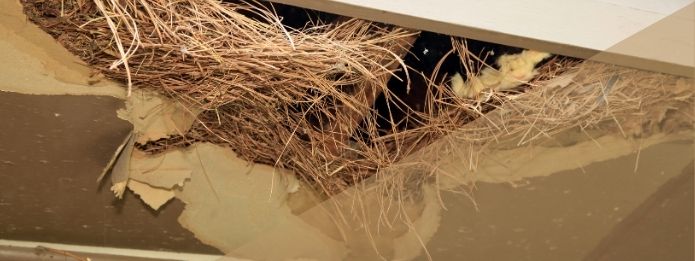
Looking around your home, would you know a rat’s nest if you saw one? Most people wouldn’t, and that’s a problem. There are serious problems rats can cause for homeowners, so recognizing their nests is essential in getting rid of the infestation. When you do find a nest in your home, it’s time to call in the rat control Guelph professionals at Truly Nolen Canada.
Characteristics of a Rat’s Nest
A rat’s nest looks just like you might imagine it would: Messy! Rats make their nests out of cotton, twigs, plants and all sorts of man-made debris. This might include fabric, cardboard, packing peanuts, paper and a wide range of other shredded scrap items. These materials are packed into cozy spaces where the rats feel protected from the elements and from predators. If you’re unsure if what you have found is a rat’s nest, there are some signs you can look and listen for:
- Droppings and Urine – Rat urine is unmistakable, as it has the musky smell of ammonia. When dry, it looks chalky, and you’ll find it all around a rat’s nest. You’ll also see droppings, which will be larger than mouse droppings; about ¾ inch long. The droppings are dark until dry, after which they become gray and flaky. If you have an infestation, you’ll find at least 40 or 50 new droppings each day.
- Holes in the Wall – Something interesting about rats is their sharp teeth can chew through concrete. If there’s a hole through your foundation or even the wooden elements of your home, and that hole leads to a messy compilation of shredded debris, you’ve most likely found a rat’s nest.
- Scratching Noises – Rats are generally quiet, but if they’re in the process of building a nest or protecting the nest, you could hear scratching, squeaking or hissing coming from inside the walls, attic or basement of your home.
- Marks on the Walls – When rats go back and forth from their nest, they leave greasy fur marks along the walls to mark the trail. This helps these blurry-visioned creatures stay on track.
Where Rat’s Nests Are Typically Found
When rats are looking for a good location to nest, they typically look for somewhere safe, and that often means they’ll move right inside your home. Some things they consider when looking for a location include:
- Close Proximity to Food and Water – Just like most creatures, rats need access to food and water. Unfortunately, they’ll find it in your home. Keep your food tight and secure, but keep in mind they will chew through something to get what they want. Anywhere you have sitting water, they’ll have access to something to drink. This could be a leaky faucet, a well-used shower or near a crack in your foundation where sprinkler water runs in.
- Warmth and Security – Rat babies need a nest that is dry, warm and safe. Inside the walls of your home is a typical location, as is the attic or the basement where predators can’t get them.
- Access to Nesting Materials – Rats will use almost anything to create a nest, so this is probably last on their list of requirements, but they do need access to nesting materials. They might use garbage, grass, leaves, blankets, socks or most anything else, so pay attention to what you’re missing.
What You Can Do If You Find a Nest
Spring is generally a good time to pay close attention to this issue, as rats typically breed during the warmer summer months. Taking care of the issue today could help you avoid an infestation. If you find a rat’s nest, stay away from it and call in the rat control Guelph professionals right away. At Truly Nolen Canada, we are committed to safely removing the problem from your home so you don’t have to deal with the unhealthy and damaging risks that come with rats. Contact us today by filling in our online form to schedule your inspection.